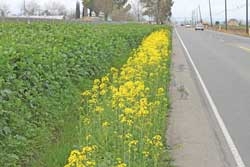Jun 9, 2011
There is a lot of information out there! While looking for something else, I ran across a Western Farm Press article from last fall about Roundup Ready canola growing on roadsides etc. I've heard Doug Munier talk about this issue and I'm sure many of you have too. I though Harry Kline did a nice job of summarizing the issue so I thought I'd revisit it today.
The article can be found here: http://westernfarmpress.com/management/rr-canola-evolves-vexing-weed

Several years ago, Doug Munier (UCCE in Glenn Co) and Kent Brittan (UCCE in Yolo Co) were part of a team testing canola as an alternative crop in California - primarily for use as a biofuel. The researchers, like the majority of the canola industry, used glyphosate-tolerant (ie. RoundupReady) canola cultivars because of the economical and effective weed control. Unfortunately, the research showed that the economics of the cropping system probably means that canola is not going to be a great fit for the Sacramento Valley. That's too bad because we can always use more viable cropping options.
That might have been the end of the story except that they noticed quite a lot of canola growing on roadsides in subsequent years. It turned out that it was volunteer canola growing along roadsides where glyphosate was the only herbicide used for vegetation management. Canola, which is related to many of our weedy mustards, is probably best described as "semi domesticated". Compared to more domesticated crops, canola shatters more seed before and during harvest and has some seed dormancy. It also has very small seed which makes it difficult to contain during transport. Because the county and CalTrans tend to depend on glyphosate for several reasons (cost, environmental concerns, etc), most other weeds were controlled and only the resistant crop volunteers were left.
To me, this is not really about escaped canola or even about glyphosate tolerant crops. Instead, it is an interesting case study of weed escapes, invasion, and population dynamics in response to limited control measures. Just like in any cropping systems, dependence on one control measure can shift weed populations to something that is not effectively controlled. Seeds move around due to wind, water, machinery, livestock, etc. If a niche is open due to disturbance (or removing most other competitors with glyphosate) some plant species or biotype may become established.
Make a point to scout your fields or areas of responsibility, correctly identify your weed problems, and design appropriate control strategies that rely on multiple tools - not just one herbicide!